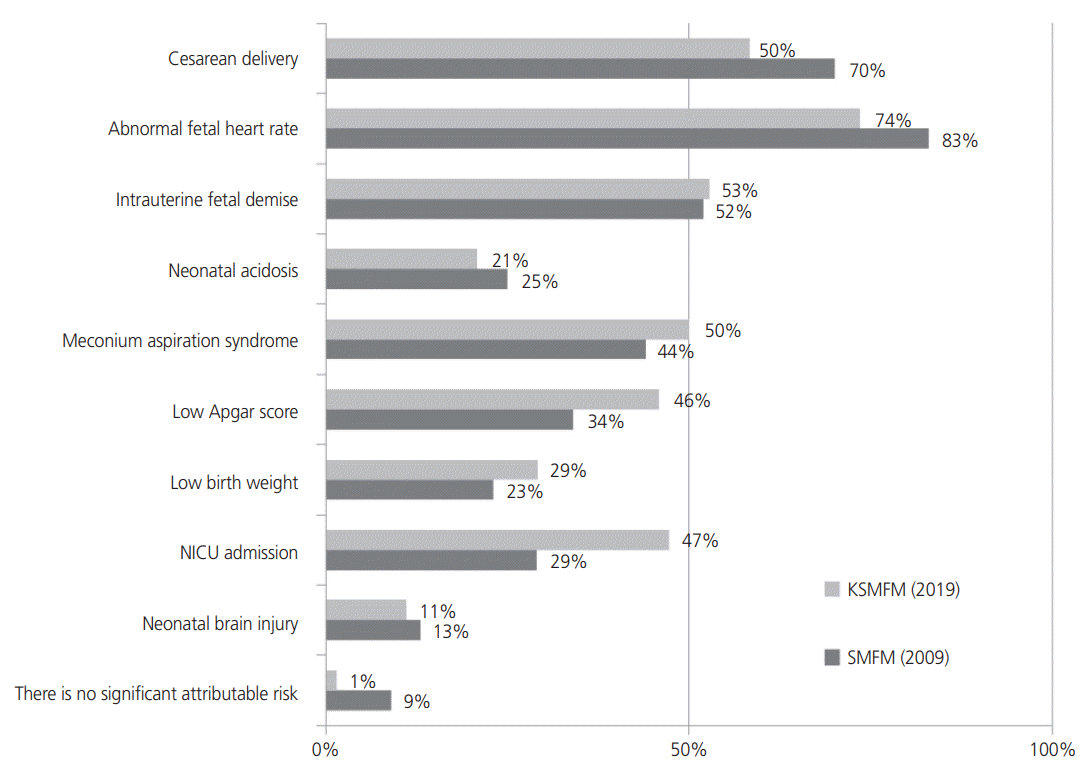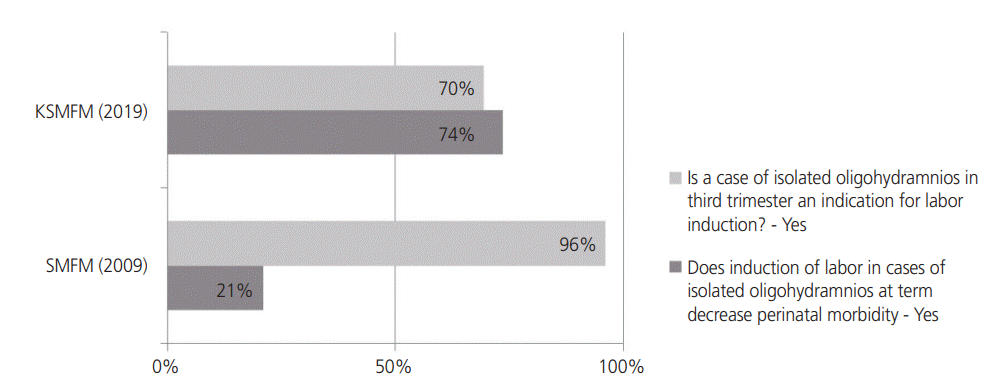1. Dubil EA, Magann EF. Amniotic fluid as a vital sign for fetal wellbeing. Australas J Ultrasound Med. 2013; 16:62–70.

2. Timor-Tritsch IE, Farine D, Rosen MG. A close look at early embryonic development with the high-frequency transvaginal transducer. Am J Obstet Gynecol. 1988; 159:676–81.

3. Chauhan SP, Cowan BD, Magann EF, Roberts WE, Morrison JC, Martin JN Jr. Intrapartum amniotic fluid index. A poor diagnostic test for adverse perinatal outcome. J Reprod Med. 1996; 41:860–6.
4. Chauhan SP, Sanderson M, Hendrix NW, Magann EF, Devoe LD. Perinatal outcome and amniotic fluid index in the antepartum and intrapartum periods: a metaanalysis. Am J Obstet Gynecol. 1999; 181:1473–8.

5. Rossi AC, Prefumo F. Perinatal outcomes of isolated oligohydramnios at term and post-term pregnancy: a systematic review of literature with meta-analysis. Eur J Obstet Gynecol Reprod Biol. 2013; 169:149–54.

6. Zhang J, Troendle J, Meikle S, Klebanoff MA, Rayburn WF. Isolated oligohydramnios is not associated with adverse perinatal outcomes. BJOG. 2004; 111:220–5.

7. Rabie N, Magann E, Steelman S, Ounpraseuth S. Oligohydramnios in complicated and uncomplicated pregnancy: a systematic review and meta-analysis. Ultrasound Obstet Gynecol. 2017; 49:442–9.

8. Gizzo S, Noventa M, Vitagliano A, Dall’Asta A, D’Antona D, Aldrich CJ, et al. An update on maternal hydration strategies for amniotic fluid improvement in isolated oligohydramnios and normohydramnios: evidence from a systematic review of literature and meta-analysis. PLoS One. 2015; 10:e0144334.

9. Schwartz N, Sweeting R, Young BK, Schwartz N, Sweeting R, Young BK. Practice patterns in the management of isolated oligohydramnios: a survey of perinatologists. J Matern Fetal Neonatal Med. 2009; 22:357–61.

10. Shrem G, Nagawkar SS, Hallak M, Walfisch A. Isolated oligohydramnios at term as an indication for labor induction: a systematic review and meta-analysis. Fetal Diagn Ther. 2016; 40:161–73.

11. Peipert JF, Donnenfeld AE. Oligohydramnios: a review. Obstet Gynecol Surv. 1991; 46:325–39.
12. Munn MB. Management of oligohydramnios in pregnancy. Obstet Gynecol Clin North Am. 2011; 38:387–95.

13. Mayer A, Erez O, Novack L, Bashiri A, Wiznitzer A, Mazor M. Chronic hypertension is an independent risk factor for preeclampsia and preterm delivery in women with rheumatologic diseases: a population-based study. Eur J Obstet Gynecol Reprod Biol. 2007; 133:157–63.

14. Brzezinski-Sinai NA, Stavsky M, Rafaeli-Yehudai T, Yitshak-Sade M, Brzezinski-Sinai I, Imterat M, et al. Induction of labor in cases of late preterm isolated oligohydramnios: is it justified? J Matern Fetal Neonatal Med. 2019; 32:2271–9.

15. Charles D, Jacoby HE. Preliminary data on the use of sodium aminohippurate to determine amniotic fluid volumes. Am J Obstet Gynecol. 1966; 95:266–9.

16. Rosati P, Guariglia L, Cavaliere AF, Ciliberti P, Buongiorno S, Ciardulli A, et al. A comparison between amniotic fluid index and the single deepest vertical pocket technique in predicting adverse outcome in prolonged pregnancy. J Prenat Med. 2015; 9:12–5.

17. Magann EF, Nolan TE, Hess LW, Martin RW, Whitworth NS, Morrison JC. Measurement of amniotic fluid volume: accuracy of ultrasonography techniques. Am J Obstet Gynecol. 1992; 167:1533–7.

18. Rutherford SE, Smith CV, Phelan JP, Kawakami K, Ahn MO. Four-quadrant assessment of amniotic fluid volume. Interobserver and intraobserver variation. J Reprod Med. 1987; 32:587–9.
19. Nabhan AF, Abdelmoula YA. Amniotic fluid index versus single deepest vertical pocket: a meta-analysis of randomized controlled trials. Int J Gynaecol Obstet. 2009; 104:184–8.

20. Ashwal E, Hiersch L, Melamed N, Aviram A, Wiznitzer A, Yogev Y. The association between isolated oligohydramnios at term and pregnancy outcome. Arch Gynecol Obstet. 2014; 290:875–81.

21. ACOG Committee opinion No. 764 summary: medically indicated late-preterm and early-term deliveries. Obstet Gynecol. 2019; 133:400–3.
22. Moore TR. The role of amniotic fluid assessment in indicated preterm delivery. Semin Perinatol. 2011; 35:286–91.

23. Jo JH, Choi YH, Wie JH, Ko HS, Park IY, Shin JC. Fetal Doppler to predict cesarean delivery for non-reassuring fetal status in the severe small-for-gestational-age fetuses of late preterm and term. Obstet Gynecol Sci. 2018; 61:202–8.

24. Oh SY. Management of isolated oligohydramnios between 34+0 and 36+6 weeks of gestation. Korean J Perinatol. 2013; 24:229–36.
25. Hofmeyr GJ, Gülmezoglu AM, Novikova N. Maternal hydration for increasing amniotic fluid volume in oligohydramnios and normal amniotic fluid volume. Cochrane Database Syst Rev. 2002; (1):CD000134.





 PDF
PDF Citation
Citation Print
Print





 XML Download
XML Download